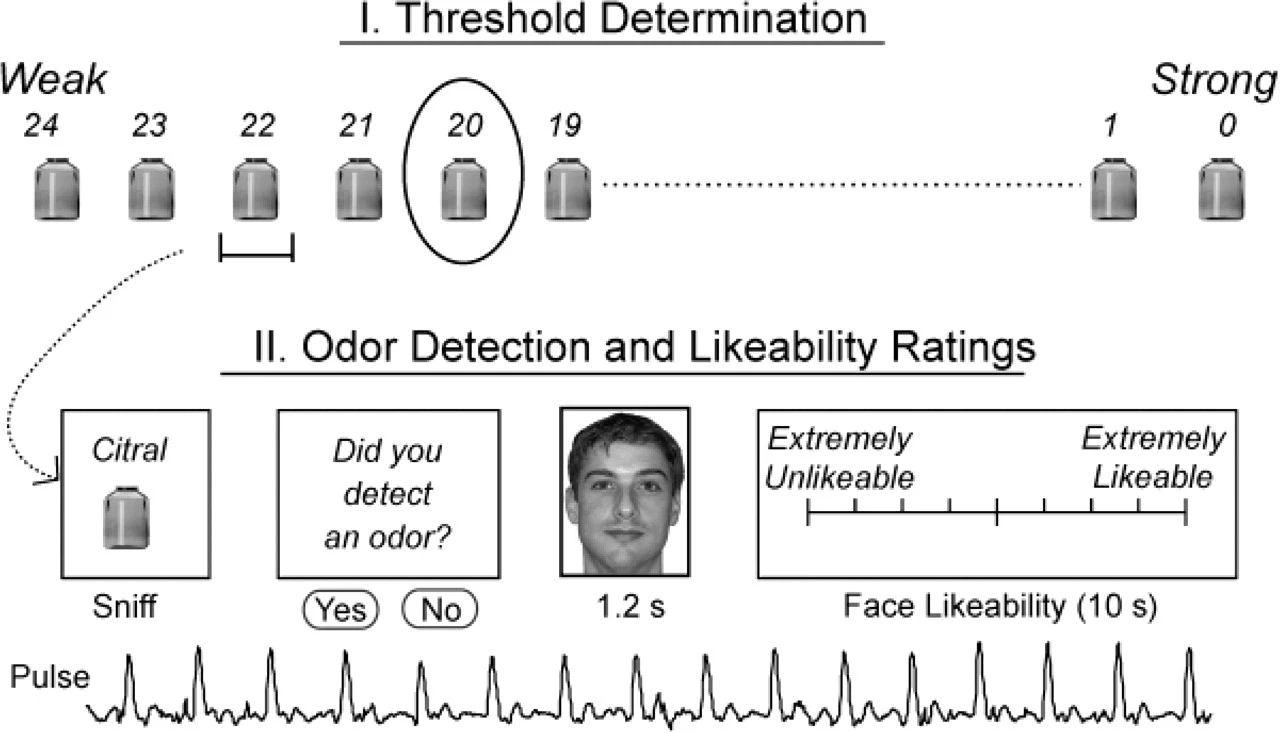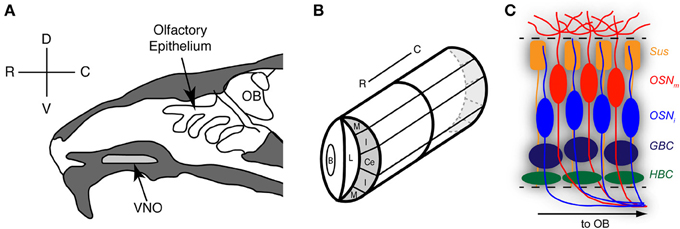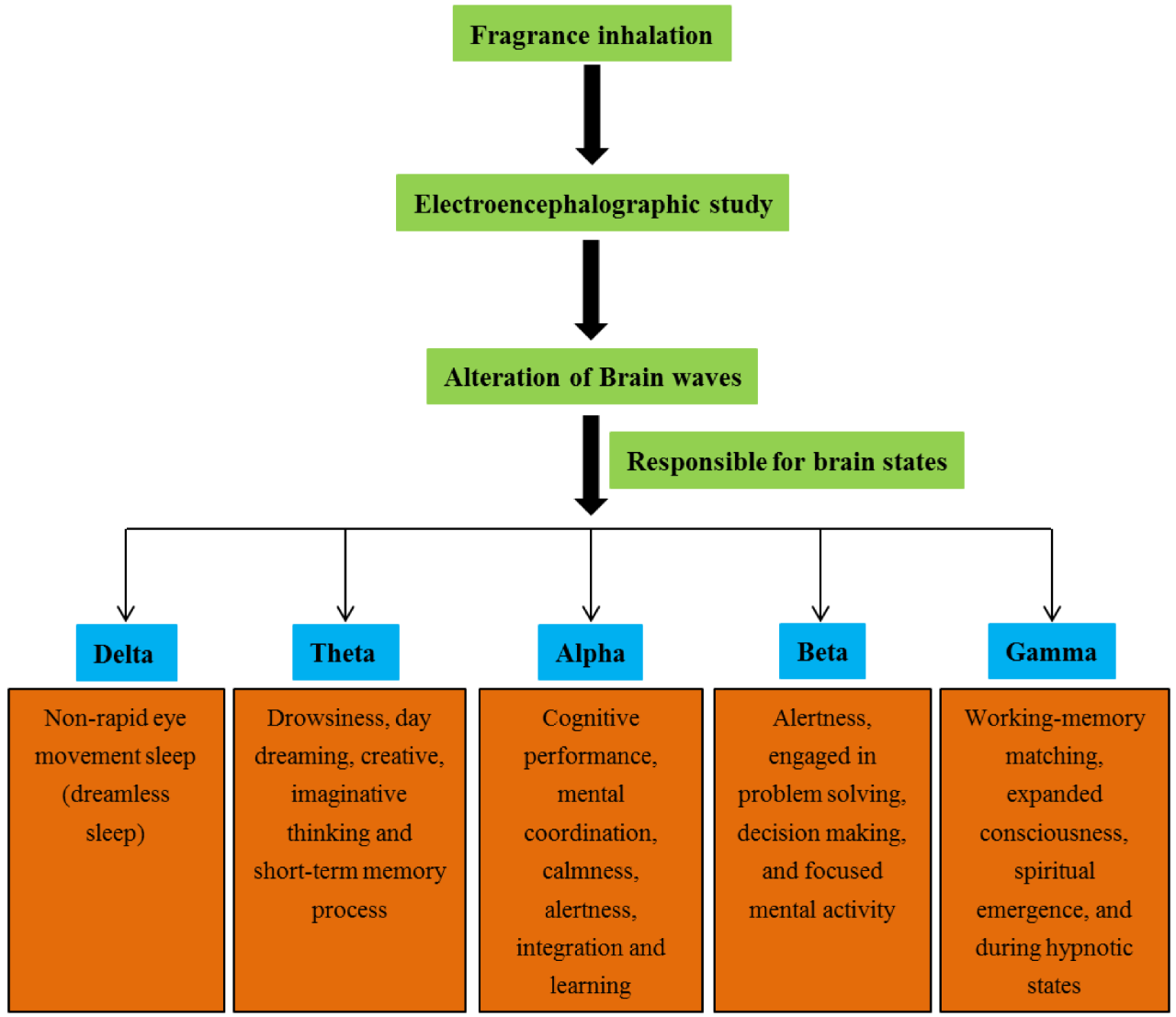服务热线
177-5061-9273


为什么大型香水公司要建立EEG部门?香味能唤起记忆、思想和感情,而嗅觉是一门复杂的科学。
在纽约、圣保罗、巴黎和新加坡(仅举几例)的高层建筑中,你可以找到现代香水行业的实验室和办公室。
这就是那些精通香水艺术(和科学)的人,将有趣的气味分子混合在一起,最终形成微小的香油滴,不仅可以进入你梳妆台上的一瓶香水或须后水,还可以进入你的洗衣液、沐浴露、洗碗皂、止汗剂……。
下次你洗澡或淋浴时,看看肥皂或洗发水的瓶子。在配料表中,你通常能找到“香料fragrance”这个词。
但这个词并不能公平地描述隐藏在这9个字母背后的数十亿美元的产业。如果我告诉你这些公司有脑电图部门。是的,脑电图。
也许你会问,究竟为什么像高砂、德之馨和奇华顿这样的香水公司要使用EEG?
对香味的感知
气味就像图像或音乐一样,能够唤起记忆,影响你的想法和感觉。事实上,这甚至已经发展成为一个完整的芳香疗法领域,旨在治愈你的压力,改善你的情绪(参见Rachel Herz的综述https://www.tandfonline.com/doi/full/10.1080/00207450802333953)。

气味好还不够。现在,人们期望香水能提升情绪、平静情绪,甚至能提高注意力——人们很快就把这些功能和其他功能结合起来了。“我们拥有的数据显示,80%的消费者正在寻找一种改善他们健康的方法,而他们通常在他们使用的品牌中找不到这种方法……
更重要的是,气味通常是在潜意识层面上起作用的,你甚至都没有注意到——看看西北大学研究人员的这项研究(https://journals.sagepub.com/doi/full/10.1111/j.1467-9280.2007.02023.x)吧。

实验范式。首先,使用上升楼梯程序确定参与者特定的气味检测阈值。然后,参与者完成一项气味检测和喜好判断任务。在本例中,检测阈值为稀释20,因此在主要任务中使用稀释22。在这项任务中,参与者嗅了一个瓶子,指出它是否含有气味,观看了一个面部刺激,最后评价了这张脸的受欢迎程度。对于一部分参与者,记录了心率。
然而,我们对气味的感知反应并不像对视觉或听觉刺激那么直接。
当你闻到一种由100多种不同成分混合而成的香水时,你只需要考虑它的化学动力学就能意识到它有多复杂。不同的分子以不同的速度到达你的鼻子。知觉体验随着每一次呼吸、每一次嗅闻而变化。香味会随着时间的推移而变化,所以你第一次使用香味产品时闻到的味道和几小时后闻到的味道是不同的。更不用说随着时间的推移,你会适应和习惯香味,这意味着你的鼻子和大脑都会在重复或持续接触气味的情况下降低对气味的敏感度和反应。
还有一个额外的因素是,你的嗅觉在你的一生中是可塑的。你的鼻子和大脑之间的连接路径会根据你的嗅觉体验不断更新。不仅在产前和童年时期,而且在你成年后,也会改变你对香味的感知方式(参见杰西卡·布兰恩和斯图尔特·费尔斯坦的这篇综述https://www.frontiersin.org/articles/10.3389/fnins.2014.00182/full)。

小鼠嗅觉上皮的组织和区域。(A)啮齿动物鼻子的矢状图,描绘了嗅觉上皮和犁鼻器(VNO)的位置。(B) VNO为双侧对称管状结构;这里显示的是一个冠状面的一半,因为它将通过这个结构的深度出现。边缘区(M)位于VNO的极端背侧(D)和腹侧(V)区域。与边缘带相邻的是中间带(I),中间带和中间带之间是中心带(Ce)。OB,嗅球;OE,嗅上皮;B,血管;C,尾;L,腔;R,吻侧。《神经科学杂志》(Brann and Firestein, 2010)授权转载。(C)嗅觉上皮由五种原始细胞类型组成,包括水平基底细胞(HBC)、球形基底细胞(GBC)、未成熟嗅觉感觉神经元(OSNi)、成熟嗅觉感觉神经元(OSNm)和支撑细胞(Sus)。
香味和脑电图
即使对最专业的嗅觉脑电图研究人员来说,嗅觉感知的复杂性也构成了相当大的挑战。但是,除了使用脑电图(EEG)之类的技术(见脑电图测量什么?有关此技术的更多信息)。
无线脑电图系统的进步(参见将神经技术带出实验室)为这些香水公司的研究部门提供了以一种经济、快速和有意义的方式测量实时大脑反应的机会,以支持香水开发过程。这可以帮助他们理解气味和其他感官之间的多感官相互作用;为了测量注意力投入的程度;或者研究香水的情感影响。
的确,不同的香味会在大脑活动中产生根本不同的动态反应。
韩国江原国立大学的植物研究人员sonndharajan和Kim在这里总结了EEG对不同植物香味的反应的一些不同研究结果。各种研究证明了从植物中提取的各种香精油具有唤醒(激活)或放松的特性,通常是通过分析主要的脑电图频段,如α和β。这些信息可以被香水公司用来指导他们的香水开发过程。(https://www.mdpi.com/2218-0532/84/4/724)

脑电波自然地出现在活动状态和休息状态。我们的思想、情绪和行为都是大脑中神经元活动的反映。脑电波的激活是神经元电活动的特征,特别是大脑中神经元离子流产生的电压波动。脑电图测量这些电活动,并将其表示为波或振荡。通常,这些脑电波代表了整个大脑的特定功能。脑电图可能受睡眠、脑功能障碍、药物和年龄等因素的影响。根据大脑功能的不同状态,有许多从0.05到500hz不等的独立波段。当我们感到疲倦、迟钝或做梦时,频率较低的脑电波占主导地位。另一方面,当我们感到兴奋或高度警觉时,较高的频率占主导地位。以下频段类别与治疗最相关(图2)。
理解个人和文化偏好
从研究的角度来看,EEG可以帮助这些全球组织的科学家揭示世界各地不同人群和文化中嗅觉反应的差异,以了解经验、文化和个性如何导致对香味的感知和偏好的差异。这也说明了为什么有些人更喜欢果香、花香,而有些人更喜欢木质、泥土味。并展示了这种多样性是如何在人类大脑的复杂世界中表现出来的。
当然,脑电图不能告诉你如何创造完美的香水。这仍然是香水大师的工作,他们在世界各地的一些香水学校接受了多年的培训。这些人的专业知识被如此珍视,以至于他们的香水配方都是最高机密,只有少数人知道。
但下次当你用有香味的肥皂洗手,或把刚洗好的衣服收起来时,停下来想一想你的脑电图会是什么样子。为了支持这一想法,这里有一张人们已经发现的表格(摘自桑德哈拉贾和金,2016年)
表:吸入香气对脑电图活动的影响
| S. No. | Odorant Materials | EEG Wave Changes | Brain Functions |
| 1. | Galaxolide | Alpha decreased. | Odors produce divided attention even when undetected. |
| 2. | m-Xylene | Alpha increased. | Stimulating and excitatory effects. |
| 3. | Birch tar, galbanum, heliotropine, jasmine, lavender, lemon and peppermint | Increased theta for birch tar, jasmine, lavender and lemon. | Subjects differed in their subjective responses to the odors. |
| 4. | 5-α-Androstan-3-one, bangalol, white sapphire, indole, linalyl acetate, eucalyptus oil and ammonia. | Alpha increased. | From more anterior electrodes—related to psychometric responses. |
| 5. | Phenylethyl alcohol and valeric acid | Valeric acid—alpha 2 increased. | Unpleasant odor leads to a cortical deactivation. |
| 6. | Lavender and rosemary | Lavender—beta increased. Rosemary—frontal alpha and beta decreased. | Lavender—increased drowsiness. Rosemary—increased alertness. |
| 7. | Synthetic odors—almond, chocolate, spearmint, strawberry, vegetable, garlic, onion and cumin Odors of real foods—chocolate, baked beans and rotting pork | Chocolate odor—less theta activity. | Reduced level of attention. |
| 8. | Chewing of marketed gum | Alpha power increased. | Arousal psychosomatic responses. |
| 9. | Valeriana off, Lavandula off, Passiflora incarnata, Piper methysticum, Melissa off, Eschscbolzia californica, Hypericum perforatum and Ginkgo biloba | Valerian extract—delta and theta activity increased and beta activity decreased. | Self-rated tiredness increased under some of the plant extracts. |
| 10. | (R)-(−)-, (S)-(+)- and (RS)-(±)-forms of linalools | (RS)-(±)-linalool—greater decrease of the beta wave after work than before work. | (RS)-(±)-linalool and (R)-(−)-linalool -favorable impression. (S)-(+)-linalool—unfavorable impression. |
| 11. | Chewing regular gum or gum base without flavor | Alpha-2 and beta-2 increased for regular gum and decreased for gum base. | Activates different brain neuronal populations. |
| 12. | Sedative effects—lemon, lavender and sandalwood Awakening effects—jasmine, ylang-ylang, rose and peppermint | Awakening fragrances—decreased alpha and beta activities. | Sedative fragrances—improvement in productivity. Awakening fragrances—effect in mitigating the workload. |
| 13. | Lavender, chamomile, sandalwood and eugenol | Alpha 1 decreased at parietal and posterior temporal regions. | Subjects felt comfortable. |
| 14. | Chewing gum with and without flavor and flavored aromatic oil | Chewing gum with flavor and inhale aromatic oil increase alpha and beta waves. | Induce concentration with a harmonious high arousal state in brain function. |
| 15. | Enantiomers of linalools | (R)-(−)-linalool—beta decreased after hearing environmental sound. Mental work—beta increased. | Odor perception and responses—chiral dependence and also with task dependence. |
| 16. | Aroma of soybeans heated to various temperatures | Alpha wave increased—heated after immersion in fructose–glycine solution. | Amino-carbonyl reaction aroma products increase brain alpha waves. |
| 17. | β-Damascenone | Non-significant trend for left frontal differences in EEG associated with different liking responses. | Left frontal response associated with liking an odor. |
| 18. | Lavender and rosemary aromas | Induce left frontal EEG shifting in adults and infants with greater baselines than right frontal EEG activation. | Associated with greater approach behavior and less depressed affect. |
| 19. | General workers, perfume salespersons and professional perfume researchers | Professional perfume researchers respond to odors mainly in the frontal region. | Functional coupling for people—occupationally exposed to odors may be related to psychological preference. |
| 20. | Lavender and rosemary | Increased relative left frontal EEG asymmetry. | Infants of depressed and non-depressed mothers respond differently to odors. |
| 21. | Para-cresol 4-methylphenol, 2-heptanone, methional 3-methylthiopropionaldehyde and dimethyltrisulphide. | Theta wave activation in frontal region between the different populations. | Cultural differences in odor responsiveness. |
| 22. | Pleasant odor | Beta wave increased in the left frontal region. | Enhancement of left frontal brain region by a pleasant odor. |
| 23. | Neroli and grapefruit oils | Slow alpha (8–10 Hz) and theta activities increased in the occipital region. | Reduce the cortical deactivation or promote a relaxed state. |
| 24. | Low-dose alcohol | Theta power decreased in both hemispheres in the high-dose condition. | Corresponding to working memory demand. |
| 25. | Odor of incense and rose oil | Fast alpha activity increased in bilateral posterior regions during incense exposure. | Cortical and function of inhibitory processing of motor response. |
| 26. | Citrus bergamia oil | Negative percentage changes of the ratio of low to high frequency in the music, aroma and combined groups than control group. | Listening to soft music and inhaling Citrus bergamia essential oil—effective method of relaxation. |
| 27. | Abies sibirica essential oil | Increased theta activity after the visual display terminal task. | Prevention of visual display terminal—mental health disturbance. |
| 28. | Lavandula angustifolia | Good sleep quality—occipital and parietal alpha decreased, frontal theta and occipital beta increased. Poor sleep quality—theta increased in the all cranial regions. | Beneficial effect for female adults with sleep disorder. |
| 29. | Lavender oil | Theta and alpha activities increased. | Relaxing effect of inhaling lavender oil. |
| 30. | Essential oil of Zizyphus jujuba seeds | Fast alpha increased in the left prefrontal, right prefrontal and left frontal regions. | Increasing attention and relaxation. |
| 31. | Essential oil of Mentha arvensis L. f. piperascens aerial parts | Relative fast alpha increased. Gamma and the spectral edge frequency 90% decreased. | Reducing mental stress. |
| 32. | Jasmine oil | Beta wave increased in the anterior center and left posterior regions. | Increased—feeling of well-being, active, fresh and romantic. |
| 33. | Ylang–ylang essential oil | Prolonged the latencies of P300 | Not affect information processing resources in patients with TLE. |
| 34. | Essential odors—mint and lemon Commerical odors—criton-verbena, lize, melody and rozan | All odors affected the EEG waves in at least some subjects. | Essential odors stimulated more than commercial odors and women are more sensitive than men. |
| 35. | Pan-fired Japanese green tea (Koushun and Kouju) | Kouju affect the beta 1 at right frontal region. | Improve memory task performance. |
| 36. | Magnolia kobus flower | Absolute alpha decreased at left parietal region. | Awaken and increase the concentration states of brain. |
| 37. | Strawberry aroma (food) and the odor of lily of the valley (non-food) | Specific scalp potential maps for the two conditions. | Food odor—associated with the processing of rewards. Non-food odor—reflects odor characteristics excluding the reward. |
| 38. | Hyperbaric oxygen exposure | Fast delta decreased and alpha increased in the posterior regions. | Oxygen-toxicity diving-related problems. |
| 39. | Lemon, peppermint, and vanilla | Theta showed statistically significant results between different odor conditions | Stimuli can affect the frequency characteristics of the electrical activity of the brain. |
| 40. | Isomers of limonene and terpinolene | (+)-Limonene—relative high beta increased in the right temporal region. Terpinolene—relative mid beta decreased and relative fast alpha increased in the right prefrontal region. | Terpinolene—reducing the tension and increasing the relaxation and stabilization states of brain function. |
| 41. | Essential oil of Inula helenium root | Theta (in all the regions except T3), beta (Fp1) and mid beta (P4) and relative theta (Fp1, Fp2, F3 and F4) decreased. | Enhance the alertness state of brain. |
| 42. | Lavender and bergamot | The absolute theta increased at the right prefrontal region Significant differences in the relative fast and slow alpha. | Both physical and mental states became more stable and relaxed. |